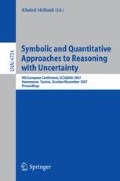Abstract
The Transferable Belief Model (TBM) relies on belief functions and enables one to represent and combine a variety of knowledge from certain up to ignorance as well as conflict inherent to imperfect data. A lot of applications have used this flexible framework however, in the context of temporal data analysis of belief functions, a few work have been proposed. Temporal aspect of data is essential for many applications such as surveillance (monitoring) and Human-Computer Interfaces. We propose algorithms based on the mechanisms of Hidden Markov Models usually used for state sequence analysis in probability theory. The proposed algorithms are the “credal forward”, “credal backward” and “credal Viterbi” procedures which allow to filter temporal belief functions and to assess state sequences in the TBM framework. Illustration of performance is provided on a human motion analysis problem.
Access this chapter
Tax calculation will be finalised at checkout
Purchases are for personal use only
Preview
Unable to display preview. Download preview PDF.
References
Rabiner, L.R.: A tutorial on hidden Markov models and selected applications in speech recognition. Proc. of the IEEE 77, 257–285 (1989)
Murphy, K.P.: Dynamic Bayesian Networks: Representation, inference and learning. PhD thesis, UC Berkeley (CSD) (2002)
Shah, M.: Understanding human behavior from motion imagery. Machine Vision and Applications 14, 210–214 (2003)
Smets, P., Kennes, R.: The Transferable Belief Model. Artificial Intelligence 66(2), 191–234 (1994)
Ramasso, E., Pellerin, D., Rombaut, M.: Belief Scheduling for the recognition of human action sequence. In: Int. Conf. on Inf. Fusion, Florence, Italia (2006)
Pieczynski, W.: Multisensor triplet Markov chains and theory of evidence. IJAR 45, 1–16 (2007)
Smets, P.: Beliefs functions: The Disjunctive Rule of Combination and the Generalized Bayesian Theorem. IJAR 9, 1–35 (1993)
Xu, H., Smets, P.: Evidential reasoning with conditional belief functions. Uncertainty in Artificial Intelligence 94, 598–606 (1994)
Yaghlane, B.B., Smets, P., Mellouli, K.: Directed evidential networks with conditionnal belief functions. In: Nielsen, T.D., Zhang, N.L. (eds.) ECSQARU 2003. LNCS (LNAI), vol. 2711, pp. 291–305. Springer, Heidelberg (2003)
Yaghlane, B., Smets, P., Mellouli, K.: Belief Function Independence: II. The Conditional Case. IJAR 31, 31–75 (2000)
Dubois, D., Prade, H.: A set-theoretic view of belief functions – Logical operations and approximation by fuzzy sets. I. J. of Gen. Sys. 12(3), 193–226 (1986)
Delmotte, F., Smets, P.: Target identification based on the Transferable Belief Model interpretation of Dempster-Shafer model. IEEE TSMC 34(4), 457–471 (2004)
Ristic, B., Smets, P.: The TBM global distance measure for the association of uncertain combat ID declarations. Information Fusion 7, 276–284 (2006)
Denoeux, T., Yaghlane, A.B.: Approximating the combination of belief functions using the fast Moebius transform in a coarsened frame. IJAR 37, 77–101 (2002)
Ramasso, E., Panagiotakis, C., Rombaut, M., Pellerin, D.: Human action recognition in videos based on the Transferable Belief Model – Application to athletics jumps. Pattern Analysis and Applications (2007)
Panagiotakis, C., Ramasso, E., Tziritas, G., Rombaut, M., Pellerin, D.: Shapemotion based athlete tracking for multilevel action recognition. In: 4th Int. Conf. on Articulated Motion and Deformable Object, Spain, pp. 385–394 (2006)
Vannoorenberghe, P., Smets, P.: Partially supervised learning by a Credal EM approach. In: Godo, L. (ed.) ECSQARU 2005. LNCS (LNAI), vol. 3571, pp. 956–967. Springer, Heidelberg (2005)
Dubois, D., Prade, H., Smets, P.: New semantics for quantitative possibility theory. In: Benferhat, S., Besnard, P. (eds.) ECSQARU 2001. LNCS (LNAI), vol. 2143, pp. 410–421. Springer, Heidelberg (2001)
Mercier, D., Quost, B., Denoeux, T.: Refined modeling of sensor reliability in the belief function framework using contextual discounting. Information Fusion (to appear)
Author information
Authors and Affiliations
Editor information
Editors and Affiliations
Rights and permissions
Copyright information
© 2007 Springer-Verlag Berlin Heidelberg
About this paper
Cite this paper
Ramasso, E., Rombaut, M., Pellerin, D. (2007). Forward-Backward-Viterbi Procedures in the Transferable Belief Model for State Sequence Analysis Using Belief Functions. In: Mellouli, K. (eds) Symbolic and Quantitative Approaches to Reasoning with Uncertainty. ECSQARU 2007. Lecture Notes in Computer Science(), vol 4724. Springer, Berlin, Heidelberg. https://doi.org/10.1007/978-3-540-75256-1_37
Download citation
DOI: https://doi.org/10.1007/978-3-540-75256-1_37
Publisher Name: Springer, Berlin, Heidelberg
Print ISBN: 978-3-540-75255-4
Online ISBN: 978-3-540-75256-1
eBook Packages: Computer ScienceComputer Science (R0)

